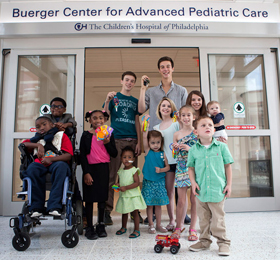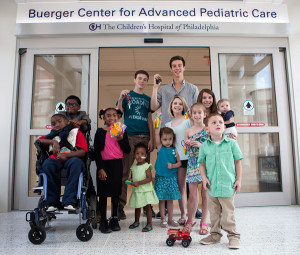
Editor’s Note: This is the first in an occasional series of conversations with leaders in patient engagement. EngagingPatients.org recently spoke with Rachel Biblow, senior director of patient and family services at the Children’s Hospital of Philadelphia (CHOP). CHOP was named a winner of the Sherman Award for Excellence in Patient Engagement earlier this year.
Rachel Biblow’s path to patient and family engagement began when she walked in the front door of the Children’s Hospital of Philadelphia as an intern 15 years ago.
“I looked up in our atrium and thought, this place is magical,” she said. “There’s something very special about being entrusted to care for probably the most important person in someone’s life.
“I knew immediately I wanted to be part of it.”
She was hired after graduation from the University of Pennsylvania and has held a number of different roles. For the past seven years, she has been focused on patient-centered care and family services.
It was this work with teenagers and families that led to her philosophy about patient and family engagement: An “unwavering commitment to partner with patients and families—an unwavering commitment to be inclusive and truly partner.”
Understanding the needs of patients and families
Early in her career, Biblow recognized the need for patients and families to be more involved in care. “Especially in pediatrics, it’s really hard to design care without talking to families,” she said.
It’s important to understand what patients and families’ lives are like outside of the walls of the hospital—to understand what their real lives are like and understand their goals.
“We need to do a better job of understanding where our patients and families are coming from,” she said. “What is the information they need in their hands when they leave the hospital?
“We need to find ways to mutually guide the work,” she said. “You (parents) know your kids better than anyone. Our team knows the medical side. We need to match both pieces together to make sure the care plan works.”
As senior director of patient and family services, Biblow has oversight for social work, family relations, language services, spiritual care and family centered care programming including patient and family experience/satisfaction and the hospital’s resource centers.
She leads the overall design and implementation of an organization-wide patient and family experience strategy to improve overall patient and family engagement and satisfaction.
A shift to partnership
Since joining CHOP, Biblow said she has seen a shift in healthcare…for the better.
“It’s no longer this passive experience,” she said. “It’s much more participatory and a partnership. It’s about an experience that includes shared goals for achieving optimal health and well-being.”
Biblow credits CHOP’s success with an outstanding leadership team and philosophy. The hospital is deeply committed to partnering with patients and families in all they do—including designing care from the bottom up as in the case of their Sherman Award winning project, the Buerger Center for Advanced Pediatric Care. When CHOP officials started planning the new building, they integrated patients and families into the process from the start. “Families truly impacted the blueprints from day one,” Biblow said.
Dispelling myths
While Biblow’s team focuses on how to build on great experiences system-wide and harness a level of partnership with families, it’s not always easy. There can be a lack of understanding about what patient-family-centered care means. Her team educates through workshops, Grand Rounds and sharing stories. They use families as ambassadors to help educate and share and they focus on best practices around conversation: The good, better and best ways to have conversations with families—conversations that are clear, informative, while still full of grace and compassion and care.
They emphasize and model patient and family engagement and partnership and dispel myths. “It’s not about the patient is always right,” she said. “It’s a different way of interacting, a more progressive way. Medicine is about relationships and relationships boil down to partnerships.”
More than patient satisfaction scores
Patient and family engagement also is not the same as patient satisfaction scores. Patient satisfaction scores are a limiting way of understanding experience, she says. They don’t encompass all that patient and family engagement is: Safety, empathy, quality, communication.
We need, Biblow said, to “open the aperture on a camera lens and look at the 360 view of experience and engagement.”
What does Biblow consider the most pressing issue in the patient engagement space? It’s teaching everyone in an organization—from parking attendants and cafeteria workers to nurses and physicians—to communicate with compassion. She advocates for broad-based education that shows how to build relationships with patients and families.
“I don’t think anybody signs up to communicate poorly,” she said. “We need to take the guilt and shame out of it. We need to allow ourselves to be vulnerable. We can do this together.”
A true payoff
Ultimately, she said, patient and family engagement and partnership pays off in many ways including improved outcomes, satisfaction and loyalty. Patients and families who feel engaged become an organization’s best ambassadors because they can speak personally about their experiences.
“An investment in this saves time on the back end. We have to find ways within the healthcare system where we create time. This is what’s going to change the delivery of care.”
Healthcare organizations can ask themselves some questions to help guide their path to change: Are we investing in patient-family education that is truly engaging in a way that patients and families need? What are we handing people when they leave? Are we giving them information in the way that works best for them? Are we connecting in ways they need?
As healthcare continues to transform, Biblow said she believes there will be a better understanding of patient experience, a different way to measure that experience and improved partnerships between patients and families and providers.
“I hope health systems invest in a very thoughtful way,” she said. “I hope healthcare paces itself,” she said. “This is not a sprint. It’s truly an evolution but we do need to pick up our pace. We need to be agile and flexible and not abandon the commitment, our unwavering commitment to patients and families.”
Rachel Biblow’s 3 must haves for a universal standard of patient engagement:
- Include patients and families in all initiatives (board committees, speaking at employee orientations—to remind them why they are there).
- Every touch point matters—it’s about consistency. Every touch point in the care continuum ties back to a patient and family.
- Invest in your people and work as one team (Our people are our greatest asset and we can achieve exceptional outcomes when we work together).







